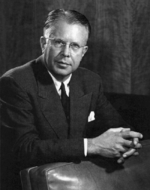Lawrence, Ernest Orlando

Ernest Orlando Lawrence (1901-1958), an American physicist who received the 1939 Nobel Prize for Physics for his invention of the cyclotron (1929), a device used to accelerate nuclear particles to very high velocities without the use of high voltage. The swiftly moving particles were used to bombard atoms of various elements, disintegrating the atoms to form, in some cases, completely new elements. His cyclotron produced technetium, the first artificial element. Lawrence's basic design was utilized in developing other particle accelerators, which have been largely responsible for the great advances made in the field of particle physics. With the cyclotron, he produced radioactive phosphorus and other isotopes for medical use, including radioactive iodine for the first therapeutic treatment of hyperthyroidism. In addition, Lawrence instituted the use of neutron beams in cancer treatment. During World War II, he worked with the Manhattan Project as a Program Chief in charge of the development of the electromagnetic process of separating uranium-235 for the atomic bomb. Lawrence Berkeley Laboratory at Berkeley, California; Lawrence Livermore National Laboratory at Livermore, California; and element 103, lawrencium, were all named in his honor.
Further Reading
- Lawrence Berkeley National Laboratory. Lawrence and His Laboratory.
- Nobel Foundation. Ernest Lawrence - Biography.